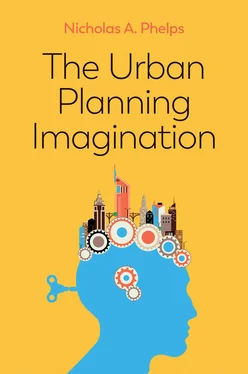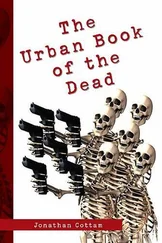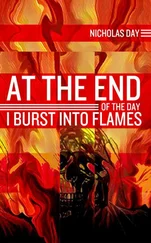1 Cover
2 Dedication Dedication For 苗田 and Yulia Elizabeth Phelps
3 Title Page The Urban Planning Imagination A Critical International Introduction NICHOLAS A. PHELPS polity
4 Copyright Page Copyright Page Copyright © Nicholas A. Phelps 2021 The right of Nicholas A. Phelps to be identified as Author of this Work has been asserted in accordance with the UK Copyright, Designs and Patents Act 1988. First published in 2021 by Polity Press Polity Press 65 Bridge Street Cambridge CB2 1UR, UK Polity Press 101 Station Landing Suite 300 Medford, MA 02155, USA All rights reserved. Except for the quotation of short passages for the purpose of criticism and review, no part of this publication may be reproduced, stored in a retrieval system or transmitted, in any form or by any means, electronic, mechanical, photocopying, recording or otherwise, without the prior permission of the publisher. ISBN-13: 978-1-5095-2624-6 ISBN-13: 978-1-5095-2625-3(pb) A catalogue record for this book is available from the British Library. by Fakenham Prepress Solutions, Fakenham, Norfolk NR21 8NL The publisher has used its best endeavours to ensure that the URLs for external websites referred to in this book are correct and active at the time of going to press. However, the publisher has no responsibility for the websites and can make no guarantee that a site will remain live or that the content is or will remain appropriate. Every effort has been made to trace all copyright holders, but if any have been overlooked the publisher will be pleased to include any necessary credits in any subsequent reprint or edition. For further information on Polity, visit our website: politybooks.com
5 List of figures and tables List of figures and tables Figures 2.1 Urban planning actors and mixes of actors 2.2 Plaza de las Tres Culturas, Mexico City 2.3 Four geographical metaphors 3.1 Thirteen specializations and their overlaps in twenty-six accredited US planning schools 3.2 Informal housing behind Thamrin Square shopping mall, central Jakarta 3.3 Melbourne’s Victoria Market and downtown 3.4 Renaturing of a storm channel in Bishan, Singapore 3.5 How to reframe economic development 4.1 Graffiti on a Melbourne road sign 4.2 Pathways of urban development in the southeast of England 5.1 Inside the planning gallery in Bandung, Indonesia 5.2 Los Arenales, Antofagasta, Chile
Figures Tables Tables 6.1 Informal contrasts between types of planning systems
6 Preface
7 1 Introduction: what is planning?Introduction The urban planning imagination Who plans? History and the urban planning imagination Geography and the urban planning imagination Urban planning’s enduring appeal The structure of the book Notes
8 2 Imagination: what is planning’s spirit and purpose?Introduction Who plans? Citizens Clubs States Mixes of actors The history and temporality of planning Macro-historical change: empires, economic systems and states Meso-level institutions of states The micro-level The temporalities of urban planning The geography of the urban planning imagination Bounded places: neighbourhood, city, region, nation, metropolis and megalopolis Sites and neighbourhoods Regional planning Megalopolitan realities National planning Networks, flows and virtual urban planning Cities as nodes within networks Flows: the metabolism of cities Virtuality and synchronicity Conclusion Notes
9 3 Substance: what are the objects of planning?Introduction Shelter Cities without slums: seeing like a state Housing as externality: club solutions to state failings House as home: the latent informality of household desires Health Water, food and air The infirmity of the city? Mobility Automobility and its systemic urban planning legacies High-speed rail and aeromobility: the interplaces yet to come? Virtual mobility and its effects Sustainability Environmental designations: the paradoxes of planning for the city and its other Eco- and other city forms Urban metabolism in an urban age of climate change and hazards Economy Economic growth: a state obsession The circular urban economy The alternative economies of clubs and citizens Conclusion Notes
10 4 Wisdom: what does planning teach us?Introduction Justice and equity The tragedy of the commons and other wicked problems Urban planning, externalities and land-value capture Externalities Private property, externalities, betterment and compensation Unintended consequences Planning failures great and small Self-fulfilling prophecies of planning for mobility Failures to plan with nature Inabilities to control urban sprawl Participation and the lack of it Conclusion Notes
11 5 Methods: what are the means of planning?Introduction City as organism: the art and science of urban planning City as system: the predicting, providing and nudging of the state Smart cities: the city as a mine of data City as scenario: clubthink Cities and citizens: participation in planning Public participation Communicative action and urban planning Planning without statutory planning: agonism, co-production and radicalism Mixes of methods for new urban planning imaginaries Planning’s artistry Experimentation Planning rhetoric Conclusions Notes
12 6 Comparisons: what are the global variations in planning?Introduction Comparative approaches Politics, political and administrative science Geography and history National planning systems and cultures Planning systems: formal contrasts in law and administration Culture: the local personalities of planning Models of welfare and national economic development Liberal markets European welfare models Predatory systems South Asian democracies Developmental systems China Born globals Conclusion Notes
13 7 Exchanges: what are the global connections in planning?Introduction The who, what and how of exchange Nation states, empires and urban planning Urban planning’s global iron cage? The Europeanization of urban planning Global urban planning governance? Clubs: planning for extraordinary desires The seductive power of urban planning Urban planning by and for a TCC Urban planning and the mediation of urban tastes Pick-and-mix planning Citizens: planning for ordinary needs Conclusion Notes
14 8 Prospects: what is the future of planning?Introduction The limits of citizens, clubs and states as urban planners Citizens Planning in the name of clubs W(h)ither the state? The city as laboratory: productive mixes of the urban planning imagination? Conclusion: urban planning’s disciplinary dialogues
15 References
16 Index
17 End User License Agreement
1 Chapter 6Table 6.1 Informal contrasts between types of planning systems
1 Chapter 2 Figure 2.1Urban planning actors and mixes of actors Figure 2.2Plaza de las Tres Culturas, Mexico City Figure 2.3Four geographical metaphors
2 Chapter 3 Figure 3.1Thirteen specializations and their overlaps in twenty-six accredited US planning... Figure 3.2Informal housing behind Thamrin Square shopping mall, central Jakarta Figure 3.3Melbourne’s Victoria Market and downtown Figure 3.4Renaturing of a storm channel in Bishan, Singapore Figure 3.5How to reframe economic development
3 Chapter 4 Figure 4.1Graffiti on a Melbourne road sign Figure 4.2Pathways of urban development in the southeast of England
4 Chapter 5 Figure 5.1Inside the planning gallery in Bandung, Indonesia Figure 5.2Los Arenales, Antofagasta, Chile
Читать дальше












![Nicholas Timmins - The Five Giants [New Edition] - A Biography of the Welfare State](/books/701739/nicholas-timmins-the-five-giants-new-edition-a-thumb.webp)